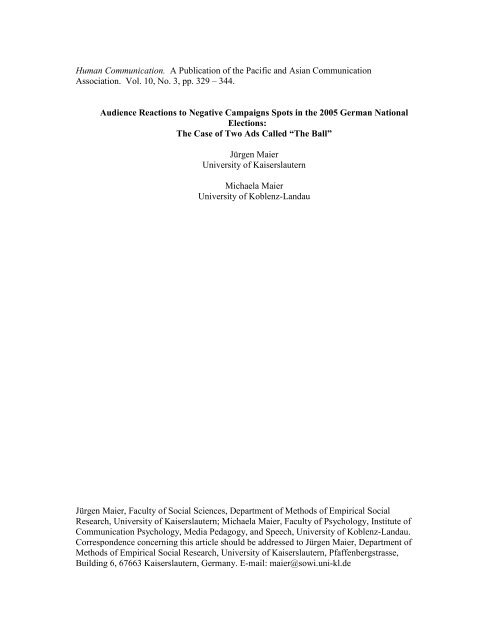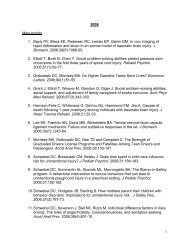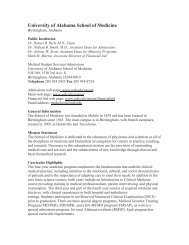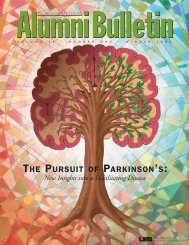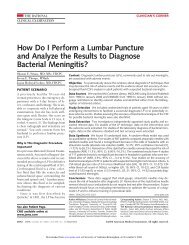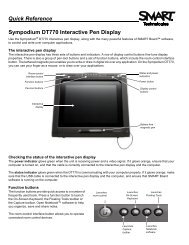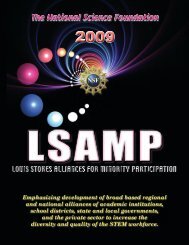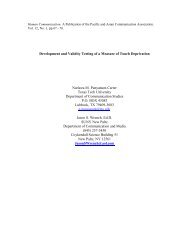Human Communication. A Publication of the Pacific and Asian ...
Human Communication. A Publication of the Pacific and Asian ...
Human Communication. A Publication of the Pacific and Asian ...
Create successful ePaper yourself
Turn your PDF publications into a flip-book with our unique Google optimized e-Paper software.
<strong>Human</strong> <strong>Communication</strong>. A <strong>Publication</strong> <strong>of</strong> <strong>the</strong> <strong>Pacific</strong> <strong>and</strong> <strong>Asian</strong> <strong>Communication</strong><br />
Association. Vol. 10, No. 3, pp. 329 – 344.<br />
Audience Reactions to Negative Campaigns Spots in <strong>the</strong> 2005 German National<br />
Elections:<br />
The Case <strong>of</strong> Two Ads Called “The Ball”<br />
Jürgen Maier<br />
University <strong>of</strong> Kaiserslautern<br />
Michaela Maier<br />
University <strong>of</strong> Koblenz-L<strong>and</strong>au<br />
Jürgen Maier, Faculty <strong>of</strong> Social Sciences, Department <strong>of</strong> Methods <strong>of</strong> Empirical Social<br />
Research, University <strong>of</strong> Kaiserslautern; Michaela Maier, Faculty <strong>of</strong> Psychology, Institute <strong>of</strong><br />
<strong>Communication</strong> Psychology, Media Pedagogy, <strong>and</strong> Speech, University <strong>of</strong> Koblenz-L<strong>and</strong>au.<br />
Correspondence concerning this article should be addressed to Jürgen Maier, Department <strong>of</strong><br />
Methods <strong>of</strong> Empirical Social Research, University <strong>of</strong> Kaiserslautern, Pfaffenbergstrasse,<br />
Building 6, 67663 Kaiserslautern, Germany. E-mail: maier@sowi.uni-kl.de
Jürgen Maier <strong>and</strong> Michaela Maier 330<br />
Abstract<br />
For <strong>the</strong> 2005 German national elections <strong>the</strong> Social Democratic Party (SPD) <strong>and</strong> <strong>the</strong><br />
Christian Democrats (CDU/CSU) each produced a TV-ad called “The Ball” (“Die Kugel”).<br />
Both ads were unusual for German campaigns for two reasons: <strong>the</strong>y explicitly attacked <strong>the</strong><br />
political opponent, <strong>and</strong> one ad referred to <strong>the</strong> o<strong>the</strong>r. The question this paper focuses on is:<br />
How did German voters react to <strong>the</strong>se negative spots. In order to test <strong>the</strong> impact <strong>of</strong> <strong>the</strong> spots,<br />
an experiment was conducted with 51 citizens using written pretest- <strong>and</strong> posttestquestionnaires<br />
as well as real-time response measurement. The major finding <strong>of</strong> this paper is<br />
that both spots received negative evaluations; <strong>the</strong>y were not able to damage <strong>the</strong> image <strong>of</strong> <strong>the</strong><br />
political opponent but instead led to a negative backlash for <strong>the</strong> own party respectively <strong>the</strong><br />
own c<strong>and</strong>idate.
AUDIENCE REACTIONS TO NEGATIVE CAMPAIGNS SPOTS 331<br />
Audience Reactions to Negative Campaigns Spots in <strong>the</strong> 2005 German National<br />
Elections:<br />
The Case <strong>of</strong> Two Ads Called “The Ball<br />
After <strong>the</strong> senior partner <strong>of</strong> <strong>the</strong> governing coalition in Berlin, <strong>the</strong> Social Democratic<br />
Party (SPD), had lost nine state elections between 2003 <strong>and</strong> 2005, Chancellor Gerhard<br />
Schröder announced on May 22 nd , 2005, that he was seeking a re-election <strong>of</strong> <strong>the</strong> German<br />
national parliament (“Bundestag”) in order to receive a new electoral m<strong>and</strong>ate for his politics.<br />
On July 1 st , he asked <strong>the</strong> parliament for a vote <strong>of</strong> confidence (“Vertrauensfrage”) – <strong>the</strong> only<br />
(but a highly controversial) possibility provided by <strong>the</strong> German constitution to call for early<br />
elections ahead <strong>of</strong> schedule. As intended, Schröder lost <strong>the</strong> role-call vote; only 151 <strong>of</strong> 600<br />
representatives voted for him. Three weeks later, Federal President Horst Köhler announced<br />
that <strong>the</strong> early election would be held on September 18 th , 2005.<br />
As dem<strong>and</strong>ed by <strong>the</strong> constitution, a very short election campaign <strong>of</strong> a maximum <strong>of</strong> 60<br />
days followed <strong>the</strong> dissolvement <strong>of</strong> <strong>the</strong> parliament. Although <strong>the</strong> parties already started to<br />
campaign on <strong>the</strong> day <strong>of</strong> Köhler’s decision on July 21 st , last doubts about <strong>the</strong> scheduling <strong>of</strong> <strong>the</strong><br />
election day were not resolved until <strong>the</strong> decision <strong>of</strong> <strong>the</strong> Federal Constitutional Court on<br />
August 25 th (i.e. 25 days before election day), dismissing an action <strong>of</strong> two members <strong>of</strong> <strong>the</strong><br />
parliament. But aside from <strong>the</strong> tight schedule <strong>and</strong> <strong>the</strong> fact that for <strong>the</strong> very first time a woman<br />
<strong>and</strong> an East German politician in <strong>the</strong> person <strong>of</strong> Angela Merkel was running for chancellor, <strong>the</strong><br />
course <strong>of</strong> <strong>the</strong> campaign was quite normal <strong>and</strong> included <strong>the</strong> traditional spectrum <strong>of</strong> political<br />
advertisement (i.e. interpersonal communication with voters in public places or public events,<br />
posters, television advertising) as well as one televised debate.<br />
In order to promote <strong>the</strong>ir top c<strong>and</strong>idates, <strong>the</strong> campaign teams <strong>of</strong> <strong>the</strong> two major parties,<br />
<strong>the</strong> SPD <strong>and</strong> <strong>the</strong> Christian Democrats (CDU/CSU), each produced an ad called “The Ball”<br />
(“Die Kugel”) in a television format. Both ads were exceptional for German election<br />
campaigns. On <strong>the</strong> one h<strong>and</strong>, <strong>the</strong> spots were remarkable because <strong>the</strong>y referred to each o<strong>the</strong>r:<br />
The SPD spot was a parody <strong>of</strong> <strong>the</strong> CDU spot. Interaction between campaign spots is not<br />
common in Germany because <strong>of</strong> <strong>the</strong> specifics <strong>of</strong> <strong>the</strong> television system. In 1984, <strong>the</strong><br />
broadcasting system was split up into public <strong>and</strong> private channels. According to a series <strong>of</strong><br />
decisions by <strong>the</strong> Federal Constitutional Court, <strong>the</strong> two public TV channels (ARD <strong>and</strong> ZDF)<br />
have to fulfill <strong>the</strong> task to inform <strong>the</strong> public. To do so in <strong>the</strong> context <strong>of</strong> elections, public<br />
television does not only cover <strong>the</strong> campaign but also provides free airtime for <strong>the</strong> campaign<br />
spots <strong>of</strong> every political party allowed to participate in an election. In national <strong>and</strong> European<br />
elections, each channel provides air time for eight spots with a maximum length <strong>of</strong> 90<br />
seconds for <strong>the</strong> two major parties CDU <strong>and</strong> SPD, four spots for all o<strong>the</strong>r parties represented<br />
in <strong>the</strong> national parliament, <strong>and</strong> two spots for small parties not represented in <strong>the</strong> national<br />
parliament (see Holtz-Bacha, 2000). Because <strong>the</strong> number <strong>of</strong> free spots is strictly limited, <strong>the</strong><br />
number <strong>of</strong> spots produced for <strong>the</strong> campaigns is very small – usually, <strong>the</strong> parties produce only<br />
a single spot. As a consequence, televised campaign ads do not refer to each o<strong>the</strong>r. Parties are<br />
also allowed to air campaign spots on private TV channels, where <strong>the</strong>y have to buy<br />
commercial time at regular market prices. Because this is very expensive, only <strong>the</strong> two major<br />
parties regularly make use <strong>of</strong> this opportunity. But in order to keep <strong>the</strong> costs within<br />
reasonable limits, <strong>the</strong>y usually shorten <strong>the</strong> spots produced for public TV.<br />
On <strong>the</strong> o<strong>the</strong>r h<strong>and</strong>, <strong>the</strong> two spots were extraordinary for German campaigns because<br />
<strong>of</strong> <strong>the</strong>ir degree <strong>of</strong> negativity. German campaign spots generally have a positive tone. Longterm<br />
studies show that criticizing statements or attacks against <strong>the</strong> political opponent appear<br />
only in about three out <strong>of</strong> ten spots aired in <strong>the</strong> context <strong>of</strong> national elections (see Holtz-<br />
Bacha, 2000; Holtz-Bacha & Kaid, 1995). Critical statements are very seldom found in <strong>the</strong><br />
spots <strong>of</strong> <strong>the</strong> two major parties. Between 1957 <strong>and</strong> 1998, <strong>the</strong> CDU <strong>and</strong> SPD expressed critique
Jürgen Maier <strong>and</strong> Michaela Maier 332<br />
in only 15 respectively 23 percent <strong>of</strong> <strong>the</strong> sequences in <strong>the</strong>ir campaign spots. Of course, <strong>the</strong><br />
number <strong>of</strong> critical statements was even lower at <strong>the</strong> times when <strong>the</strong> CDU or respectively SPD<br />
were in government <strong>and</strong> above average when <strong>the</strong>y were in opposition (see Holtz-Bacha,<br />
2000). In contrast, <strong>the</strong> CDU version <strong>of</strong> “The Ball” contains 13 verbal statements, eight <strong>of</strong><br />
which (62 percent) are critical <strong>of</strong> or attack <strong>the</strong> government. The rebuttal <strong>of</strong> <strong>the</strong> SPD consists<br />
<strong>of</strong> six verbal statements; five <strong>of</strong> <strong>the</strong>m (83 percent) were a direct attack on Angela Merkel.<br />
The unusualness <strong>of</strong> both versions <strong>of</strong> “The Ball” raises <strong>the</strong> question how voters reacted<br />
to <strong>the</strong>se commercials. This paper focuses on <strong>the</strong> perception, evaluation, <strong>and</strong> impact <strong>of</strong> <strong>the</strong>se<br />
spots on attitudes towards parties <strong>and</strong> c<strong>and</strong>idates which are analyzed on <strong>the</strong> basis <strong>of</strong> an<br />
experimental study conducted with a sample <strong>of</strong> German citizens. To do this, we start with a<br />
brief review <strong>of</strong> <strong>the</strong> research on <strong>the</strong> impact <strong>of</strong> televised ads in Germany. After a description <strong>of</strong><br />
<strong>the</strong> data <strong>and</strong> <strong>the</strong> stimuli shown to <strong>the</strong> participants <strong>of</strong> our study, we analyze <strong>the</strong> perception <strong>and</strong><br />
evaluation <strong>of</strong> <strong>the</strong> two spots. Finally, we focus on <strong>the</strong> impact <strong>of</strong> <strong>the</strong> campaign spots on party<br />
<strong>and</strong> c<strong>and</strong>idate evaluation.<br />
Research on Televised Ads in German Elections<br />
For German voters, televised campaign spots are one <strong>of</strong> <strong>the</strong> sources <strong>of</strong> information<br />
used most frequently in <strong>the</strong> course <strong>of</strong> election campaigns (see, e.g., Holtz-Bacha, 2000;<br />
Kliment, 1994; Schmitt-Beck, 2002; Semetko & Schönbach, 1994). Because campaign spots<br />
are broadcasted directly before or after <strong>the</strong> major evening newscasts as well as in between<br />
entertainment programs <strong>the</strong>y usually draw a large audience. Generally speaking, <strong>the</strong> reception<br />
<strong>of</strong> political television advertising is not related very strongly with voters, demographic or<br />
political characteristics (see Holtz-Bacha, 1990). Although <strong>the</strong>re is a greater probability that<br />
people with a high level <strong>of</strong> political interest will watch campaign ads, a major part <strong>of</strong> <strong>the</strong><br />
reached audiences consists <strong>of</strong> voters with low levels <strong>of</strong> political interest (see Holtz-Bacha,<br />
2000). Müller (2002) shows that about two thirds <strong>of</strong> <strong>the</strong> electorate saw at least one spot aired<br />
at prime time on public TV during <strong>the</strong> last four weeks <strong>of</strong> <strong>the</strong> 2002 German national election<br />
campaign; <strong>the</strong> average number <strong>of</strong> spots seen by <strong>the</strong> voters was 4.4. Compared to o<strong>the</strong>r<br />
countries like, e.g., <strong>the</strong> United States, this number is ra<strong>the</strong>r small. In fact, it is only about one<br />
quarter to one half as many contacts per ad as recommended by American campaign<br />
managers in order to have effects on political attitudes (e.g., Filzmaier & Plasser, 2001). As a<br />
consequence, in Germany it is unrealistic to expect any great changes <strong>of</strong> opinions by<br />
watching campaigns spots. Maybe this is <strong>the</strong> reason why most <strong>of</strong> <strong>the</strong> German campaign<br />
managers think that televised ads are not a very important type <strong>of</strong> advertising (see Müller,<br />
2002).<br />
The low expectations concerning <strong>the</strong> impact <strong>of</strong> campaign spots might be an<br />
explanation why only few studies have focused on this particular topic within <strong>the</strong> context <strong>of</strong><br />
German election campaigns. Research on <strong>the</strong> effects <strong>of</strong> televised political advertising in<br />
Germany started with a study <strong>of</strong> Holtz-Bacha (1990) on <strong>the</strong> European Union parliamentary<br />
elections in 1984 <strong>and</strong> 1989. Based on survey data, her findings suggested that exposure to<br />
campaign ads had a substantial positive impact on <strong>the</strong> attitudes toward <strong>the</strong> EU as well as<br />
toward <strong>the</strong> European integration process. In addition, voters who frequently watched<br />
campaign spots had a more favorable opinion about <strong>the</strong> campaign than voters who were not<br />
exposed to that kind <strong>of</strong> advertising. Experimental research on <strong>the</strong> 2004 European Union<br />
parliamentary election conducted with a student sample showed that <strong>the</strong> reception <strong>of</strong><br />
campaign spots negatively affected <strong>the</strong> evaluation <strong>of</strong> <strong>the</strong> political parties as well as <strong>the</strong><br />
attitudes toward EU membership (see Esser, Holtz-Bacha, & Lessinger, 2005). In contrast,<br />
watching campaign spots had no impact on political involvement, on most <strong>of</strong> <strong>the</strong> attitudes<br />
toward <strong>the</strong> EU <strong>and</strong> <strong>the</strong> European integration process, as well as on voting intentions. Esser,<br />
Holtz-Bacha, <strong>and</strong> Lessinger (2005) concluded that campaign spots do not change but<br />
reinforce political attitudes. Based on an experiment with a citizen sample, Maier <strong>and</strong> Maier
AUDIENCE REACTIONS TO NEGATIVE CAMPAIGNS SPOTS 333<br />
(2005) observed that watching campaign spots increased <strong>the</strong> knowledge about <strong>the</strong> top<br />
c<strong>and</strong>idates <strong>and</strong> changed <strong>the</strong> perception <strong>of</strong> <strong>the</strong> parties’ position toward <strong>the</strong> European<br />
integration process. Although no effects were found on <strong>the</strong> voters’ agenda <strong>of</strong> <strong>the</strong> most<br />
important problems, <strong>the</strong> reasons for voting for a particular party (but not <strong>the</strong> voting decision<br />
itself) changed after <strong>the</strong> respondents had watched <strong>the</strong> spots. In addition, Maier <strong>and</strong> Maier<br />
(2005) found that exposure to campaign ads tended to decrease political involvement. In<br />
ano<strong>the</strong>r experiment with a student sample, <strong>the</strong>y showed that especially for politically<br />
unaffiliated voters <strong>the</strong> impact <strong>of</strong> political ads on interest in <strong>the</strong> campaign depends on <strong>the</strong><br />
evaluation <strong>of</strong> <strong>the</strong> spots (see Maier & Maier, 2006). In general, <strong>the</strong> studies on <strong>the</strong> impact <strong>of</strong><br />
European election campaign spots made clear that televised political advertising can alter<br />
political attitudes but those effects are – all in all – ra<strong>the</strong>r small.<br />
The very first studies on <strong>the</strong> impact <strong>of</strong> televised ads aired during German national<br />
elections campaigns were conducted in 1990. Based on a panel study <strong>of</strong> West German voters,<br />
Semetko <strong>and</strong> Schönbach (1994) found only weak evidence that exposure to televised ads<br />
increased interest in <strong>the</strong> election. In addition, effects <strong>of</strong> TV spots on attitudes toward <strong>the</strong><br />
political parties <strong>and</strong> <strong>the</strong>ir top c<strong>and</strong>idates only occurred for <strong>the</strong> post-communists, <strong>the</strong> PDS (see<br />
Schönbach & Semetko, 1994; Semetko & Schönbach, 1994). In contrast to this, experimental<br />
studies with student samples showed that watching campaign ads caused only minor changes<br />
<strong>of</strong> <strong>the</strong> overall evaluation but had larger effects on <strong>the</strong> image <strong>of</strong> <strong>the</strong> chancellor c<strong>and</strong>idates. The<br />
direction <strong>and</strong> <strong>the</strong> size <strong>of</strong> <strong>the</strong> effects depended on gender as well as on <strong>the</strong> fact if <strong>the</strong> students<br />
lived in East or West Germany (see Holtz-Bacha & Kaid, 1995; Kaid & Holtz-Bacha, 1993a,<br />
1993b). In addition, Kaid <strong>and</strong> Holtz-Bacha (1993a) showed that watching televised ads<br />
evoked feelings about <strong>the</strong> spot. Those feelings moderated <strong>the</strong> impact <strong>of</strong> <strong>the</strong> party<br />
commercials: While positive feelings, like optimism, or excitement caused positive changes<br />
<strong>of</strong> <strong>the</strong> c<strong>and</strong>idates’ images, negative feelings, like concernment, resulted in <strong>the</strong> deterioration <strong>of</strong><br />
<strong>the</strong> images <strong>of</strong> <strong>the</strong> top c<strong>and</strong>idates.<br />
In <strong>the</strong> context <strong>of</strong> <strong>the</strong> 2005 German national election, Kaid <strong>and</strong> Postelnicu (2006)<br />
realized an online experiment with German students who watched ei<strong>the</strong>r <strong>the</strong> CDU or <strong>the</strong> SPD<br />
version <strong>of</strong> “The Ball” or both spots. They showed that <strong>the</strong> CDU spot had a significant,<br />
negative impact on <strong>the</strong> evaluation <strong>of</strong> Gerhard Schröder. In contrast, nei<strong>the</strong>r watching <strong>the</strong> SPD<br />
ad nor exposure to both spots significantly changed c<strong>and</strong>idate orientations. Kaid <strong>and</strong><br />
Postelnicu (2006) concluded that <strong>the</strong> SPD spot obviously cancelled out <strong>the</strong> negative effect <strong>of</strong><br />
<strong>the</strong> CDU ad. In addition, <strong>the</strong>y could not prove an impact <strong>of</strong> <strong>the</strong> spots on political cynicism but<br />
were able to show that <strong>the</strong> CDU spot substantially increased internal efficacy.<br />
In summary, research has generated some evidence that campaign ads aired in <strong>the</strong><br />
context <strong>of</strong> German national elections can affect attitudes toward <strong>the</strong> top c<strong>and</strong>idates. In<br />
addition, <strong>the</strong> only study published so far on <strong>the</strong> impact <strong>of</strong> <strong>the</strong> two versions <strong>of</strong> “The Ball”<br />
indicates that negative ads seem to work in <strong>the</strong> intended way, i.e. <strong>the</strong>y damage <strong>the</strong> image <strong>of</strong><br />
<strong>the</strong> political opponent.<br />
Data <strong>and</strong> Stimuli<br />
In order to test <strong>the</strong> impact <strong>of</strong> televised campaign spots on political attitudes <strong>and</strong><br />
behavior, on August 31 st (i.e. one week after <strong>the</strong> launch <strong>of</strong> <strong>the</strong> campaign ads <strong>and</strong> 19 days<br />
before <strong>the</strong> election for <strong>the</strong> German parliament) an experiment was conducted among 51<br />
citizens from L<strong>and</strong>au, a small city in Rhinel<strong>and</strong>-Palatinate. 1 In addition, a control group <strong>of</strong> 20<br />
1<br />
Recruitement <strong>of</strong> subjects took place according to a previously set up sampling plan which<br />
controlled for sex, age, <strong>and</strong> education. Whereas men <strong>and</strong> women were represented almost<br />
equally among <strong>the</strong> participants (49 vs. 51 percent), <strong>the</strong>re were some divergences in reference<br />
to participants’ age (18-29: 43 percent; 30-44: 28 percent; 45-59: 22 percent; 60 <strong>and</strong> above: 8<br />
percent) <strong>and</strong> education (elementary education: 10 percent; modern secondary school
Jürgen Maier <strong>and</strong> Michaela Maier 334<br />
citizens was recruited. 2 Six campaign spots from <strong>the</strong> parties represented in <strong>the</strong> national<br />
parliament were shown to <strong>the</strong> participants <strong>of</strong> <strong>the</strong> experiment. The second last spot shown was<br />
<strong>the</strong> CDU version, <strong>the</strong> last spot <strong>the</strong> SPD version <strong>of</strong> “The Ball”. After each spot, <strong>the</strong> subjects<br />
were asked to fill out a short questionnaire regarding <strong>the</strong>ir impressions <strong>of</strong> <strong>the</strong> particular ad,<br />
specific political attitudes, as well as <strong>the</strong>ir voting intentions. In addition, before <strong>the</strong> reception<br />
<strong>of</strong> <strong>the</strong> very first spot <strong>and</strong> after <strong>the</strong> last spot participants had to fill out an extensive<br />
questionnaire about <strong>the</strong>ir political involvement, <strong>the</strong>ir attitudes towards <strong>the</strong> political parties,<br />
<strong>the</strong> c<strong>and</strong>idates, <strong>and</strong> <strong>the</strong> political issues relevant in this campaign, about <strong>the</strong>ir voting behavior,<br />
media diet, <strong>and</strong> demographics. Finally, 50 participants were able to place second-by-second<br />
responses to <strong>the</strong> spots during <strong>the</strong> reception (“real-time response measurement”). To do so,<br />
<strong>the</strong>y were provided with 7-point dials with a scale from -3 (“very bad impression <strong>of</strong> <strong>the</strong><br />
spot”) to +3 (“very good impression <strong>of</strong> <strong>the</strong> spot”) which transmitted <strong>the</strong> ratings by <strong>the</strong><br />
respondents to a central computer every second.<br />
The content <strong>of</strong> <strong>the</strong> CDU spot shown to <strong>the</strong> participants <strong>of</strong> <strong>the</strong> study may be<br />
summarized as follows: A man drops a metal billiard ball on a conference table located in a<br />
dusky room. The ball rolls over <strong>the</strong> table, hits several objects like, e.g., pencils <strong>and</strong> a glass <strong>of</strong><br />
water, <strong>and</strong> leaves <strong>the</strong>m in disorder or broken. As <strong>the</strong> ball moves, a male voice from <strong>the</strong> <strong>of</strong>f<br />
speaks about <strong>the</strong> poor economic performance <strong>of</strong> <strong>the</strong> government during <strong>the</strong> last seven years.<br />
Shortly before <strong>the</strong> ball falls from <strong>the</strong> table, Angela Merkel stops it with her h<strong>and</strong>, talks about<br />
leadership <strong>and</strong> her political goals, <strong>and</strong> asks for political support in <strong>the</strong> upcoming election.<br />
The spot <strong>of</strong> <strong>the</strong> SPD was only provided in <strong>the</strong> internet <strong>and</strong> not aired on television. 3<br />
This spot was a rebuttal to <strong>the</strong> CDU spot <strong>and</strong> shows a woman juggling with a metal billiard<br />
ball similar to <strong>the</strong> one in <strong>the</strong> CDU spot. Although <strong>the</strong> face <strong>of</strong> <strong>the</strong> woman is not shown, it is<br />
obvious from <strong>the</strong> clo<strong>the</strong>s that she wears that this woman is supposed to represent Angela<br />
Merkel. The spot starts when <strong>the</strong> woman catches <strong>the</strong> ball falling from <strong>the</strong> table <strong>and</strong> begins to<br />
toss <strong>the</strong> ball back <strong>and</strong> forth between her h<strong>and</strong>s. From <strong>the</strong> <strong>of</strong>f, a male voice describes Merkel<br />
education: 22 percent; A levels/high school: 55 percent, still in school: 14 percent). In<br />
reference to party affiliation, which was not assessed beforeh<strong>and</strong>, it was found that<br />
government supporters participated in <strong>the</strong> survey significantly more <strong>of</strong>ten than supporters <strong>of</strong><br />
<strong>the</strong> opposition parties (CDU/CSU: 33 percent; SPD: 22 percent; FDP: 0 percent; Bündnis<br />
90/Die Grünen: 26 percent; PDS: 2 percent; no party identification: 14 percent, no answer to<br />
this question: 4 percent). All participants applied for <strong>the</strong> study in response to ads published in<br />
<strong>the</strong> daily newspaper “Die Rheinpfalz” as well as in a free weekly local newspaper <strong>and</strong><br />
received an incentive <strong>of</strong> 15 Euros. For fur<strong>the</strong>r details about <strong>the</strong> design <strong>of</strong> <strong>the</strong> study see Maier,<br />
Maier, & Klietsch (2006).<br />
2<br />
The control group was recruited from visitors <strong>of</strong> a movie <strong>the</strong>atre, while <strong>the</strong> experimental<br />
study was conducted at <strong>the</strong> University. The composition <strong>of</strong> this group is as follows: men: 50<br />
percent; 18-29 years: 70 percent, 30-44 years: 25 percent, 45-59 years: 5 percent, 60 years<br />
<strong>and</strong> older: 0 percent; elementary education: 20 percent; modern secondary school education:<br />
30 percent; A levels/high school: 45 percent, still in school: 5 percent; identification with<br />
CDU/CSU: 40 percent, SPD: 15 percent, FDP: 5 percent, Bündnis 90/Die Grünen: 20<br />
percent, Die Linkspartei. PDS: 0 percent, no party identification: 20 percent. None <strong>of</strong> <strong>the</strong><br />
differences between experimental <strong>and</strong> control group are statistically significant on <strong>the</strong> level <strong>of</strong><br />
p
AUDIENCE REACTIONS TO NEGATIVE CAMPAIGNS SPOTS 335<br />
as a flip-flopper, who cannot decide about her political goals. Finally, <strong>the</strong> woman looses<br />
control over <strong>the</strong> ball, it falls down <strong>and</strong> <strong>the</strong> voice states that Merkel is not able to decide what<br />
to do, but <strong>the</strong> voters can.<br />
Perception <strong>of</strong> <strong>the</strong> Spots<br />
In <strong>the</strong> sample <strong>of</strong> West German citizens, both versions <strong>of</strong> “The Ball” left unfavorable<br />
impressions. 4 Immediately after having watched each spot, <strong>the</strong> participants <strong>of</strong> <strong>the</strong> study were<br />
asked how <strong>the</strong>y liked <strong>the</strong> particular ad. Most people did not like <strong>the</strong>m: 26 percent enjoyed <strong>the</strong><br />
CDU spot <strong>and</strong> 38 percent disapproved <strong>of</strong> it. On average, <strong>the</strong> spot received a negative rating <strong>of</strong><br />
-.20 on a 5-point scale from -2 (“did not like <strong>the</strong> spot at all”) to +2 (“liked <strong>the</strong> spot very<br />
much”). The evaluation <strong>of</strong> <strong>the</strong> SPD ad was, on average, even worse. 38 percent rated this spot<br />
positively, but 50 percent had negative feelings; <strong>the</strong> average evaluation was -.30.<br />
More detailed information about <strong>the</strong> impressions that both spots evoked was provided<br />
by <strong>the</strong> real-time response measurement applied in this study. As Figure 1 shows, <strong>the</strong><br />
1<br />
0,5<br />
0<br />
-0,5<br />
-1<br />
CDU<br />
SPD<br />
0 10 20 30 40 50 60<br />
Time in seconds<br />
Figure 1. Perception <strong>of</strong> <strong>the</strong> Spots: Data from Real-time response measurement (7-point<br />
scale from -3 to +3).<br />
evaluation <strong>of</strong> <strong>the</strong> CDU as well as <strong>the</strong> SPD version <strong>of</strong> “The Ball” continuously dropped during<br />
<strong>the</strong> course <strong>of</strong> <strong>the</strong> spot. At <strong>the</strong> end <strong>of</strong> <strong>the</strong> 30-second spot <strong>of</strong> <strong>the</strong> SPD, <strong>the</strong> average rating was -<br />
.49. The CDU spot, which was twice as long as <strong>the</strong> SPD ad, showed an almost similar trend<br />
up to <strong>the</strong> moment when Angela Merkel stopped <strong>the</strong> ball (second 31) <strong>and</strong> started to talk about<br />
what would have to be done in Germany by <strong>the</strong> future government. After that, <strong>the</strong> spot<br />
4<br />
It is unlikely that a larger number <strong>of</strong> participants <strong>of</strong> <strong>the</strong> study had had <strong>the</strong> chance to<br />
develop an attitude toward <strong>the</strong> spots beforeh<strong>and</strong> because <strong>the</strong> CDU as well as <strong>the</strong> SPD ad were<br />
largely unknown in <strong>the</strong> sample. Only 14 percent <strong>of</strong> <strong>the</strong> participants <strong>of</strong> <strong>the</strong> study had seen <strong>the</strong><br />
CDU version <strong>of</strong> “The Ball”. Eight percent had taken a look at <strong>the</strong> parody <strong>of</strong> this ad provided<br />
on <strong>the</strong> web site <strong>of</strong> <strong>the</strong> SPD. Only one person had watched both spots.
Jürgen Maier <strong>and</strong> Michaela Maier 336<br />
evaluation went up <strong>and</strong> down. The most negative average rating <strong>the</strong> spot received was -.80.<br />
During <strong>the</strong> last 20 seconds, <strong>the</strong> spot rating dramatically improved. At its end, <strong>the</strong> average<br />
rating <strong>of</strong> <strong>the</strong> spot was -.15. Obviously, <strong>the</strong> participants <strong>of</strong> <strong>the</strong> experiment did not appreciate<br />
<strong>the</strong> attacking parts <strong>of</strong> <strong>the</strong> ads, but when <strong>the</strong> CDU spot started to talk about what would have<br />
to be done in <strong>the</strong> future <strong>and</strong> <strong>the</strong> Christian Democrats claimed that <strong>the</strong>y could solve <strong>the</strong><br />
problems, <strong>the</strong> average spot evaluation sharply increased. The explanation for this reaction is<br />
that <strong>the</strong>re is no culture <strong>of</strong> negative or comparative advertising in Germany. This is not only<br />
true for political advertising but also for regular consumer products for which comparative<br />
advertising was forbidden by German law <strong>and</strong> regarded ethically condemnable until<br />
European law allowed it in 1997. 5 First attempts to introduce comparative <strong>and</strong> <strong>the</strong>rewith<br />
negative advertising in Germany only caused negative reactions in <strong>the</strong> public <strong>and</strong> thus were<br />
ab<strong>and</strong>oned. Having this in mind, it’s easy to underst<strong>and</strong> why <strong>the</strong> participants in <strong>the</strong> study did<br />
not like this way <strong>of</strong> advertising.<br />
Even if <strong>the</strong> CDU spot created somewhat more favorable (but on average still negative)<br />
impressions toward its end, Table 1 shows that <strong>the</strong> mean score measured with help <strong>of</strong> <strong>the</strong><br />
real-time response technique was almost <strong>the</strong> same for both spots (-.34 vs. -.31). This result<br />
supports <strong>the</strong> findings <strong>of</strong> <strong>the</strong> spot evaluation by <strong>the</strong> questionnaires. 6 Females perceived both<br />
spots more negatively than males. While in <strong>the</strong> case <strong>of</strong> <strong>the</strong> CDU spot, younger participants<br />
had <strong>the</strong> most negative impressions, <strong>the</strong> SPD received its worst evaluations from older<br />
persons. In both cases, subjects with a medium level <strong>of</strong> education gave <strong>the</strong> most<br />
Table 1: Mean Value <strong>of</strong> Real-time Response Measurement by Social <strong>and</strong> Political<br />
Groups<br />
CDU spot SPD spot N<br />
Total sample -.34 -.31 50<br />
Male -.25 -.01 24<br />
Female -.43 -.59 26<br />
18-29 years -.45 .14* 21<br />
30-44 years -.48 -.38 14<br />
45-59 years -.01 -.98 11<br />
60+ years -.25 -.66 4<br />
Low education .12 -.68** 5<br />
Medium education -.58 -1.06 11<br />
High education -.34 -.02 34<br />
Identification SPD or Green Party -1.12*** -.07* 24<br />
Identification CDU/CSU or FDP .96 -.78 16<br />
No/o<strong>the</strong>r party identification -.58 -.50 10<br />
Note. Data from Real-time response measurement; 7-point scale from -3 to +3.<br />
Level <strong>of</strong> significance: * p
AUDIENCE REACTIONS TO NEGATIVE CAMPAIGNS SPOTS 337<br />
The all in all negative evaluations <strong>of</strong> <strong>the</strong> two ads are not only to be seen as a function<br />
<strong>of</strong> social or political characteristics <strong>of</strong> <strong>the</strong> respondents <strong>of</strong> <strong>the</strong> study but also a consequence <strong>of</strong><br />
<strong>the</strong> strong deviation <strong>of</strong> <strong>the</strong> spots from <strong>the</strong> German notion <strong>of</strong> an “ideal” campaign spot (Table<br />
2). Such an ideal spot, according to <strong>the</strong> statements <strong>of</strong> <strong>the</strong> test persons, should provide<br />
credible <strong>and</strong> convincing information presented in an interesting (but serious) way. In<br />
addition, it should cast a favourable light on politicians. The last thing what a campaign spot<br />
in Germany should do is to be provoking, aggressive, or to attack <strong>the</strong> political opponent.<br />
Both, <strong>the</strong> CDU <strong>and</strong> <strong>the</strong> SPD spot, differed significantly from <strong>the</strong> ideal televised ad on almost<br />
all dimensions. In <strong>the</strong> case <strong>of</strong> <strong>the</strong> CDU, <strong>the</strong> difference was especially large with respect to<br />
attacking <strong>the</strong> political opponent. For <strong>the</strong> SPD spot (which in sum showed a significantly<br />
stronger deviation from <strong>the</strong> ideal spot than <strong>the</strong> CDU ad), <strong>the</strong> most salient differences were<br />
<strong>the</strong> lack <strong>of</strong> credibility <strong>and</strong> <strong>the</strong> high amount <strong>of</strong> aggression.
Jürgen Maier <strong>and</strong> Michaela Maier 338<br />
Table 2:Characteristics <strong>of</strong> an ideal campaign spot, <strong>the</strong> CDU spot, <strong>and</strong> <strong>the</strong> SPD spot<br />
An ideal campaign spot…/<br />
<strong>the</strong> CDU (SPD) spot… a Ideal spot CDU spot SPD spot<br />
…should be/was credible 1.70<br />
…should be/was convincing 1.51<br />
-<br />
.08***<br />
-<br />
.33***<br />
…should/did provide information 1.50 .02***<br />
…should be/was interesting 1.22 .00***<br />
…should be/was not boring 1.16<br />
…should/did show responsible politicians .96<br />
-<br />
.52***<br />
-<br />
.12***<br />
…should have/had style .88 .16***<br />
…should/did show competent politicians .78<br />
…should/did show energetic politicians .38<br />
…should show/showed congenial politicians .36<br />
-<br />
.42***<br />
-<br />
.30***<br />
-<br />
.53***<br />
…should show/showed no pessimism .34 .65<br />
-<br />
.90***<br />
-<br />
.66***<br />
-<br />
.78***<br />
-<br />
.60***<br />
-<br />
.58***<br />
-<br />
-<br />
.86***<br />
-<br />
-<br />
-<br />
-<br />
.30***<br />
-<br />
.84***<br />
…should/did show appealing pictures .32<br />
-<br />
.22***<br />
…should be/was imaginative .24 -.02 .04<br />
…should be/was entertaining .04 -.14 .02<br />
…should have/had good music -.04 - -<br />
…should be/was not worrying -.13 -.42<br />
…should be/was funny -.22<br />
-<br />
1.18***<br />
-<br />
.86***<br />
…should be/was provoking -.76 .78***<br />
1.50**<br />
*<br />
…should be/was aggressive -1.04 .63***<br />
1.36**<br />
*<br />
…should/did attack <strong>the</strong> political opponent -1.14<br />
1.24**<br />
*<br />
-<br />
Mean squared difference to ideal spot<br />
3.92**<br />
*<br />
5.26<br />
N 50 50 50<br />
Note. a 5-point scales from -2 (“does not apply at all”) to +2 (“fully applies”). - = Item was<br />
not asked for <strong>the</strong> SPD spot.<br />
Levels <strong>of</strong> significance: * p
AUDIENCE REACTIONS TO NEGATIVE CAMPAIGNS SPOTS 339<br />
Party identification <strong>and</strong> <strong>the</strong> perceived difference <strong>of</strong> <strong>the</strong> ads from an ideal spot were<br />
<strong>the</strong> most powerful variables explaining <strong>the</strong> general spot evaluation (Table 3). In both cases,<br />
<strong>the</strong> impact <strong>of</strong> <strong>the</strong> discrepancy between <strong>the</strong> spots shown to <strong>the</strong> participants <strong>of</strong> <strong>the</strong> study <strong>and</strong><br />
<strong>the</strong>ir notion <strong>of</strong> an ideal campaign spot was clearly stronger than <strong>the</strong> effect <strong>of</strong> <strong>the</strong>ir party<br />
attachment. All o<strong>the</strong>r variables (i.e. sex, age, education) had no statistically significant<br />
effects on spot evaluation.<br />
Table 3: Determinants <strong>of</strong> <strong>the</strong> evaluation <strong>of</strong> <strong>the</strong> CDU <strong>and</strong> <strong>the</strong> SPD spot<br />
CDU spot<br />
SPD spot<br />
Adjusted R 2 .39 .42<br />
Sex .17 -.16<br />
Age -.06 -.14<br />
Education -.04 .10<br />
Strength <strong>of</strong> party identification .32** .33***<br />
Mean squared difference to ideal spot -.51*** -.41***<br />
N 50 50<br />
Note. Presented are <strong>the</strong> results <strong>of</strong> an OLS-regression analysis, st<strong>and</strong>ardized regression<br />
coefficients.<br />
Levels <strong>of</strong> significance: * p
Jürgen Maier <strong>and</strong> Michaela Maier 340<br />
SPD dropped about -.18 scale points. In <strong>the</strong> case <strong>of</strong> <strong>the</strong> CDU, <strong>the</strong> original spot had a small<br />
negative impact, while <strong>the</strong> rebuttal had a small positive effect. After <strong>the</strong> reception <strong>of</strong> both<br />
spots, <strong>the</strong> participants had only a slightly more positive feeling about <strong>the</strong> CDU (+.04).<br />
Looking at <strong>the</strong> evaluations <strong>of</strong> <strong>the</strong> two chancellor c<strong>and</strong>idates, <strong>the</strong> picture <strong>of</strong> <strong>the</strong> limited<br />
impact <strong>of</strong> <strong>the</strong> two spots does not change very much. In <strong>the</strong> case <strong>of</strong> Schröder, <strong>the</strong> CDU spot<br />
had a small positive effect, while <strong>the</strong> SPD spot had a minor negative influence. After subjects<br />
had watched both ads, Schröder received slightly better evaluations from <strong>the</strong> participants <strong>of</strong><br />
<strong>the</strong> experiment (+.04). The CDU spot had a significantly negative impact on Merkel, while<br />
<strong>the</strong> SPD had a small positive effect. After having watched both spots, Merkel’s image had<br />
suffered (-.16) instead <strong>of</strong> improved.<br />
All in all, it appears that <strong>the</strong> CDU spot damaged <strong>the</strong> image <strong>of</strong> <strong>the</strong> Christian Democrats<br />
<strong>and</strong> <strong>the</strong>ir top c<strong>and</strong>idate Angela Merkel instead <strong>of</strong> improving her st<strong>and</strong>ing before <strong>the</strong> elections.<br />
At <strong>the</strong> same time, <strong>the</strong> SPD spot had a negative impact on <strong>the</strong> Social Democrats as well as on<br />
Schröder. Considering this backlash effect, <strong>the</strong> main intention <strong>of</strong> both spots – namely to<br />
damage <strong>the</strong> image <strong>of</strong> <strong>the</strong> political opponent – did not work very well. Only in one case (<strong>the</strong><br />
impact <strong>of</strong> <strong>the</strong> CDU spot on <strong>the</strong> evaluation <strong>of</strong> <strong>the</strong> SPD), an ad was successful in this respect.<br />
Reactions to <strong>the</strong> campaign spots, <strong>of</strong> course, were not uniform, but <strong>the</strong> responses <strong>of</strong> <strong>the</strong><br />
participants depended on <strong>the</strong>ir spot evaluation. At <strong>the</strong> same time, <strong>the</strong> reactions did not always<br />
follow a common, clearly visible pattern. Again, <strong>the</strong>re were only few significant effects <strong>of</strong> <strong>the</strong><br />
two campaign spots (Table 5): First, for those respondents who liked <strong>the</strong> CDU spot an<br />
Table 5: Impact <strong>of</strong> <strong>the</strong> CDU <strong>and</strong> <strong>the</strong> SPD spot on party <strong>and</strong> c<strong>and</strong>idate evaluation by<br />
spot evaluation<br />
CDU spot<br />
SPD spot<br />
SPD a<br />
Total sample -.08 -.10<br />
Negative evaluation -.09 -.15<br />
Neutral evaluation -.17 -.50<br />
Positive evaluation .00 +.11<br />
CDU/CSU a<br />
Total sample -.08 +.04<br />
Negative evaluation -.11 +.03<br />
Neutral evaluation -.11 -.17<br />
Positive evaluation +.23* -.11<br />
Schröder a<br />
Total sample +.08 -.04<br />
Negative evaluation +.09 -.05<br />
Neutral evaluation +.06 -.50<br />
Positive evaluation -.08 +.05<br />
Merkel a<br />
Total sample -.26* +.10<br />
Negative evaluation -.31* .00<br />
Neutral evaluation -.06 +.33<br />
Positive evaluation +.08 +.16<br />
N 50 50<br />
Note. a Scales from -5 (“does not like [party, politician] at all”) to +5 (“like <strong>the</strong> [party,<br />
politician] very much”).<br />
Levels <strong>of</strong> significance: * p
AUDIENCE REACTIONS TO NEGATIVE CAMPAIGNS SPOTS 341<br />
be observed (-.31). In addition, <strong>the</strong>re are two interesting relationships between spot<br />
evaluation <strong>and</strong> <strong>the</strong> direction <strong>of</strong> <strong>the</strong>ir effects: On <strong>the</strong> one h<strong>and</strong>, attacking <strong>the</strong> political opponent<br />
generally did not have <strong>the</strong> intended consequences. In three out <strong>of</strong> four cases, a positive<br />
evaluation <strong>of</strong> a spot did not lead to poorer evaluation <strong>of</strong> <strong>the</strong> attacked party or person. On <strong>the</strong><br />
o<strong>the</strong>r h<strong>and</strong>, <strong>the</strong>re is a tendency that unfavorably rated televised ads damaged <strong>the</strong> image <strong>of</strong><br />
parties <strong>and</strong> politicians – <strong>of</strong> those who were target <strong>of</strong> <strong>the</strong> attack <strong>and</strong> <strong>of</strong> those who produced <strong>the</strong><br />
spot.<br />
Some studies in <strong>the</strong> field <strong>of</strong> political communication argue that negative campaign ads<br />
increase <strong>the</strong> voter’s skepticism about <strong>the</strong> political system <strong>and</strong> its representatives. In <strong>the</strong><br />
context <strong>of</strong> this analysis, this would mean that <strong>the</strong> acceptance <strong>of</strong> both parties, respectively both<br />
c<strong>and</strong>idates, should suffer from <strong>the</strong> reception <strong>of</strong> <strong>the</strong> spots. In order to measure those effects, an<br />
composite measure based on <strong>the</strong> score <strong>of</strong> <strong>the</strong> best-rated party (<strong>and</strong> in analogy to this, an index<br />
based on <strong>the</strong> score <strong>of</strong> <strong>the</strong> best-rated c<strong>and</strong>idate) was created (see, e.g., Rattinger, 1993; Maier,<br />
2000). This indicator is very common in Germany to measure dissatisfaction with political<br />
parties. The logic behind this index is that <strong>the</strong> evaluation <strong>of</strong> political parties largely depends<br />
on individual party attachments. Persons who have a specific party identification usually<br />
evaluate “<strong>the</strong>ir” party more favorably than o<strong>the</strong>r parties. Although those people have negative<br />
feelings toward many o<strong>the</strong>r parties, <strong>the</strong>y are not dissatisfied with <strong>the</strong> political parties because<br />
<strong>the</strong>y have a clear-cut picture <strong>of</strong> <strong>the</strong> political world. Because <strong>of</strong> <strong>the</strong> selective perception <strong>and</strong><br />
processing <strong>of</strong> information, it would be no surprise if watching campaign spots would increase<br />
<strong>the</strong> positive image <strong>of</strong> <strong>the</strong> party a voter is attached to <strong>and</strong> at <strong>the</strong> same time lead to more<br />
negative evaluations <strong>of</strong> o<strong>the</strong>r parties. If, in contrast to this, <strong>the</strong> reception <strong>of</strong> negative<br />
campaign spots would be followed by a decline <strong>of</strong> <strong>the</strong> created composite measures that would<br />
be a strong indicator for political cynicism caused by negative campaign spots.<br />
After watching <strong>the</strong> two versions <strong>of</strong> “The Ball”, none <strong>of</strong> <strong>the</strong> six possible effects<br />
analyzed here were statistically significant (Table 6). Never<strong>the</strong>less, after <strong>the</strong> exposure to <strong>the</strong><br />
Table 6: Impact <strong>of</strong> <strong>the</strong> CDU <strong>and</strong> <strong>the</strong> SPD spot on best party/best c<strong>and</strong>idate evaluation<br />
CDU spot SPD spot After both spots<br />
Best party evaluation a<br />
Pretest 2.56 2.44 2.56<br />
Posttest 2.44 2.46 2.46<br />
Difference -.12 +.02 -.10<br />
Best c<strong>and</strong>idate evaluation b<br />
Pretest 2.12 2.16 2.12<br />
Posttest 2.16 2.20 2.20<br />
Difference +.04 +.04 +.08<br />
N 50 50 50<br />
Note: a Index based on <strong>the</strong> best evaluation for CDU/CSU <strong>and</strong> SPD; index ranges from -5<br />
(“does not like both parties at all”) to +5 (“likes at least one <strong>of</strong> <strong>the</strong> parties very much”). b<br />
Index based on <strong>the</strong> best evaluation for Schröder <strong>and</strong> Merkel; index ranges from -5 (“does not<br />
like both c<strong>and</strong>idates at all”) to +5 (“likes at least one <strong>of</strong> <strong>the</strong> c<strong>and</strong>idates very much”).<br />
Levels <strong>of</strong> significance: * p
Jürgen Maier <strong>and</strong> Michaela Maier 342<br />
When we, once again, put aside <strong>the</strong> assumption that all participants <strong>of</strong> <strong>the</strong> experiment<br />
reacted in <strong>the</strong> same way to <strong>the</strong> campaign spots <strong>and</strong> analyze <strong>the</strong> effects <strong>of</strong> <strong>the</strong> ads by spot<br />
evaluation, <strong>the</strong> effects <strong>of</strong> <strong>the</strong> campaign spots on citizens’ satisfaction with <strong>the</strong> major political<br />
parties <strong>and</strong> <strong>the</strong> chancellor c<strong>and</strong>idates became stronger. Interestingly, <strong>the</strong> effects on <strong>the</strong> index<br />
<strong>of</strong> best party evaluation for <strong>the</strong> single spots are not very strong <strong>and</strong> not consistent (Table 7).<br />
Table 7: Impact <strong>of</strong> <strong>the</strong> CDU <strong>and</strong> <strong>the</strong> SPD spot on best party/best c<strong>and</strong>idate evaluation<br />
by spot evaluation<br />
CDU spot SPD spot After both spots c<br />
Best party evaluation a<br />
Total sample -.12 +.02 -.10<br />
Negative evaluation -.37 +.04 -.89<br />
Neutral evaluation -.11 -.17 -.07<br />
Positive evaluation +.23* +.05 +.15*<br />
Best c<strong>and</strong>idate evaluation b<br />
Total sample +.04 +.04 +.08<br />
Negative evaluation +.05 -.08 -.44<br />
Neutral evaluation .00 +.50 +.29<br />
Positive evaluation +.08 +.05 +.15<br />
N 50 50 50<br />
Note. a Index includes <strong>the</strong> best evaluation for CDU/CSU <strong>and</strong> SPD; index ranges from -5<br />
(“does not like both parties at all”) to +5 (“likes at least one <strong>of</strong> <strong>the</strong> parties very much”).<br />
b Index includes <strong>the</strong> best evaluation for Schröder <strong>and</strong> Merkel; index ranges from -5 (“does not<br />
like both c<strong>and</strong>idates at all”) to +5 (“likes at least one <strong>of</strong> <strong>the</strong> c<strong>and</strong>idates very much”). c Index <strong>of</strong><br />
best spot evaluation, includes <strong>the</strong> best evaluation for <strong>the</strong> CDU <strong>and</strong> <strong>the</strong> SPD spot; index ranges<br />
from -2 (“does not like both spots at all”) to +2 (“likes at least one <strong>of</strong> <strong>the</strong> spots very much”).<br />
Levels <strong>of</strong> significance: * p
AUDIENCE REACTIONS TO NEGATIVE CAMPAIGNS SPOTS 343<br />
Although <strong>the</strong> average ratings <strong>of</strong> <strong>the</strong> two spots were negative, <strong>the</strong> impact <strong>of</strong> <strong>the</strong> ads on<br />
party <strong>and</strong> c<strong>and</strong>idate orientations was quite limited <strong>and</strong> only in few cases statistically<br />
significant. Never<strong>the</strong>less, it was obvious that both, <strong>the</strong> CDU <strong>and</strong> <strong>the</strong> SPD spot, were not able<br />
to damage <strong>the</strong> image <strong>of</strong> <strong>the</strong> particular political opponent but ra<strong>the</strong>r caused a negative backlash<br />
on <strong>the</strong> evaluation <strong>of</strong> <strong>the</strong> own party respectively <strong>the</strong> own c<strong>and</strong>idate. This pattern is, <strong>of</strong> course,<br />
<strong>the</strong> opposite <strong>of</strong> <strong>the</strong> results reported by Kaid <strong>and</strong> Postelnicu (2006) for young German voters.<br />
A differentiation <strong>of</strong> <strong>the</strong> impact <strong>of</strong> <strong>the</strong> two ads by positive, neutral, <strong>and</strong> negative spot<br />
evaluations made clear that even in <strong>the</strong> case <strong>of</strong> positive assessments <strong>of</strong> <strong>the</strong> ads, negative<br />
campaigning did not work in <strong>the</strong> intended way (i.e. damaging <strong>the</strong> image <strong>of</strong> <strong>the</strong> political<br />
opponent). Moreover, in <strong>the</strong> case <strong>of</strong> negative evaluation <strong>the</strong> ads tended to belittle <strong>the</strong><br />
reputation <strong>of</strong> both parties <strong>and</strong> both chancellor c<strong>and</strong>idates.<br />
This observation leads to <strong>the</strong> question whe<strong>the</strong>r negative campaign spots foster<br />
dissatisfaction with parties <strong>and</strong> politicians in general. The results <strong>of</strong> <strong>the</strong> simple pretestposttest<br />
comparison yielded no effects. Again, after analyzing <strong>the</strong> effects for those<br />
participants who liked <strong>the</strong> spots <strong>and</strong> for those who did not, a much clearer pattern emerged –<br />
especially if we take a look at <strong>the</strong> changes <strong>of</strong> party <strong>and</strong> c<strong>and</strong>idate evaluations after <strong>the</strong><br />
reception <strong>of</strong> both spots. For those persons who liked at least one <strong>of</strong> <strong>the</strong> ads, <strong>the</strong> image <strong>of</strong> <strong>the</strong><br />
parties as well as <strong>of</strong> <strong>the</strong>ir top c<strong>and</strong>idates slightly improved. In contrast to this, for those<br />
participants who rejected both spots, dissatisfaction with parties <strong>and</strong> politicians increased.<br />
This result also differs from <strong>the</strong> findings <strong>of</strong> Kaid <strong>and</strong> Postelnicu (2006) reporting that <strong>the</strong> two<br />
negative ads did not create political cynicism among young voters.<br />
This study (like most <strong>of</strong> <strong>the</strong> o<strong>the</strong>r studies in this field, too) has, <strong>of</strong> course, its<br />
limitations – limitations which are typical <strong>of</strong> experimental research. In addition, we have to<br />
admit that <strong>the</strong> subsequent viewing <strong>of</strong> both versions <strong>of</strong> “The Ball” was highly unlikely for<br />
German voters, as <strong>the</strong> SPD spot was only available in <strong>the</strong> internet. Although <strong>the</strong> reception<br />
situation created in this experiment was not very realistic, <strong>the</strong> results presented in this paper<br />
confirm o<strong>the</strong>r analyses reporting that campaign spots are able to influence German voters. As<br />
<strong>the</strong> findings <strong>of</strong> previous studies on <strong>the</strong> impact <strong>of</strong> televised advertising in <strong>the</strong> course <strong>of</strong><br />
German election campaigns are very mixed, fur<strong>the</strong>r research on this topic is strongly<br />
recommended.<br />
References<br />
Esser, F., Holtz-Bacha, C., & Lessinger, E.-M. (2005). Sparsam in jeder Hinsicht: Die<br />
Fernsehwerbung der Parteien im Europawahlkampf 2004. In C. Holtz-Bacha (Ed.),<br />
Europawahl 2004: Die Massenmedien im Europawahlkampf (pp. 65-89). Wiesbaden,<br />
Germany: Verlag für Sozialwissenschaften.<br />
Filzmaier, P., & Plasser, F. (2001). Wahlkampf um das Weiße Haus: Presidential Elections in<br />
den USA. Opladen, Germany: Leske + Budrich.<br />
Holtz-Bacha, C. (1990). Nur bei den Wasserwerken Effekte? Eine Studie zur<br />
parteipolitischen Spot-Werbung vor Europawahlen. Medium, 3, 50-53.<br />
Holtz-Bacha, C. (2000). Wahlwerbung als politische Kultur: Parteienspots im Fernsehen<br />
1957-1998. Wiesbaden, Germany: Westdeutscher Verlag.<br />
Kaid, L. L., & Holtz-Bacha, C. (1993a). Audience Reactions to Televised Political Programs:<br />
An Experimental Study <strong>of</strong> <strong>the</strong> 1990 German National Election. European Journal <strong>of</strong><br />
<strong>Communication</strong>, 8, 77-99.<br />
Kaid, L. L., & Holtz-Bacha, C. (1993b). Die Beurteilung von Wahlspots im Fernsehen: Ein<br />
Experiment mit Teilnehmern in den alten und neuen Bundesländern. In C. Holtz-<br />
Bacha (Ed.), Die Massenmedien im Wahlkampf: Untersuchungen aus dem Wahljahr<br />
1990 (pp. 185-207). Opladen, Germany: Westdeutscher Verlag.
Jürgen Maier <strong>and</strong> Michaela Maier 344<br />
Kaid, L. L., & Holtz-Bacha, C. (1995). Television Spots in German National Elections. In L.<br />
L. Kaid, & C. Holtz-Bacha (Eds.), Political Advertising in Western Democracies:<br />
Parties <strong>and</strong> C<strong>and</strong>idates on Television (pp. 61-88). Thous<strong>and</strong> Oaks, CA: Sage.<br />
Kaid, L. L., & Postelnicu, M. (2006). The Impact <strong>of</strong> Television Advertising in <strong>the</strong> 2005<br />
German National Elections. Paper presented at <strong>the</strong> Midwest Political Science<br />
Association Convention, Chicago, IL.<br />
Kliment, T. (1994). Orientierung im Wahlkampf oder nur Propag<strong>and</strong>a? Wahlwerbespots im<br />
Urteil der Bevölkerung – eine Repräsentativumfrage in Hessen. Media Perspektiven,<br />
8, 419-427.<br />
Maier, J. (2000). Politikverdrossenheit in der Bundesrepublik Deutschl<strong>and</strong>: Dimensionen,<br />
Determinanten, Konsequenzen. Opladen, Germany: Leske + Budrich.<br />
Maier, J., & Maier, M. (in press). Does <strong>the</strong> Reception <strong>of</strong> European Election Campaign Spots<br />
Foster Political Involvement? Results <strong>of</strong> an Experimental Study with Young German<br />
Voters. In L. L. Kaid (Ed.), The Expansion Election: Communicating Shared<br />
Sovereignty in <strong>the</strong> 2004 European Parliamentary Elections. New York: Peter Lang.<br />
Maier, J., Maier, M., & Klietsch, K. (2006). Inhalt und Wahrnehmung von<br />
Wahlwerbesendungen der im Bundestag vertretenen Parteien zur Bundestagswahl<br />
2005 – eine Dokumentation (Kaiserslauterer Beiträge zur Sozialforschung, Nr. 2).<br />
Kaiserslautern, Germany: University <strong>of</strong> Kaiserslautern, Department <strong>of</strong> Methods <strong>of</strong><br />
Empirical Social Research.<br />
Maier, M., & Maier, J. (2005). Nebensache Europa: Parteienspots zur Europawahl 2004 und<br />
ihre Wirkung – Ergebnisse einer Experimentalstudie. In J. Tenscher (Ed.), Wahl-<br />
Kampf um Europa: Analysen aus Anlass der Wahlen zum Europäischen Parlament<br />
2004 (pp. 118-135). Wiesbaden, Germany: Verlag für Sozialwissenschaften.<br />
Müller, D. K. (2002). ARD und ZDF als Werbeträger nach 20.00 Uhr: Wahlwerbung im<br />
Fernsehen. Media Perspektiven, 12, 623-628.<br />
Müller, M. G. (2002). Parteienwerbung im Bundestagswahlkampf 2002: Eine qualitative<br />
Analyse politischer Werbung und PR. Media Perspektiven, 12, 629-638.<br />
Rattinger, H. (1993). Abkehr von den Parteien? Dimensionen der Parteiverdrossenheit. Aus<br />
Politik und Zeitgeschichte, B 11, 24-35.<br />
Schönbach, K., & Semetko, H. A. (1994). Medienberichterstattung und Parteienwerbung im<br />
Bundestagswahlkampf 1990. Media Perspektiven, 7, 328-340.<br />
Semetko, H. A., & Schönbach, K. (1994). Germany’s “Unity Election“: Voters <strong>and</strong> <strong>the</strong><br />
Media. Cresskill, NJ: Hampton Press.<br />
UWG (2004). Gesetz gegen den unlauteren Wettbewerb. Bundesgesetzblatt Jg. 2004, Teil I,<br />
Nr. 32, Bonn, 7.7.2004.


